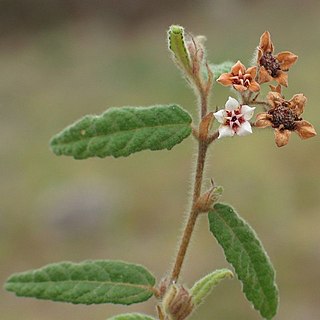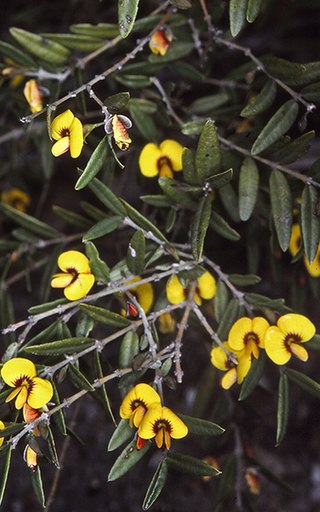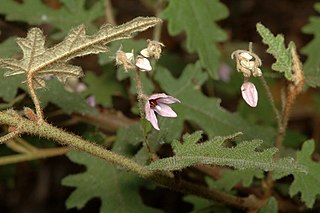
Commersonia is a genus of twenty-five species of flowering plants in the family Malvaceae. Plants in this genus are shrubs or trees, occurring from Indochina to Australia and have stems, leaves and flowers covered with star-like hairs. The leaves are simple, often with irregularly-toothed edges, the flowers bisexual with five sepals, five petals and five stamens and the fruit a capsule with five valves. The genus underwent a revision in 2011 and some species were separated from Commersonia, others were added from Rulingia.

Chorilaena quercifolia, commonly known as karri oak or chorilaena, is a species of bushy shrub that is endemic to the karri forests of south-west Western Australia. It is the sole species in the genus Chorilaena. It has papery, broadly egg-shaped leaves with lobed edges and variously-coloured flowers arranged in umbels of five, the sepals and petals hairy on the outside and the stamens protruding beyond the petals.

Kennedia coccinea, commonly known as coral vine, is a species of flowering plant in the family Fabaceae and is endemic to the south-west of Western Australia. It is a twining, climbing or prostrate shrub with trifoliate leaves and orange-pink, red and pink, pea-like flowers.

Lasiopetalum behrii, commonly known as the pink velvet bush, is a species of flowering plant in the family Malvaceae and is endemic to southern continental Australia. It is an erect shrub with lance-shaped, narrowly oblong to narrowly elliptic leaves and groups of white to pink and reddish-brown flowers.

Commersonia dasyphylla, commonly known as kerrawang, is a species of flowering plant of the family Malvaceae and is endemic to eastern continental Australia. It is a shrub with egg-shaped to lance-shaped with irregular edges and flowers in groups of up to 21, followed by hairy brown capsules.

Hibbertia hermanniifolia is a species of flowering plant in the family Dilleniaceae and is endemic to eastern Australia. It is an erect shrub with spatula-shaped to wedge-shaped leaves and yellow flowers arranged singly in leaf axils, with ten to fifteen stamens arranged around two hairy carpels.

Prostanthera saxicola is a species of flowering plant in the family Lamiaceae and is endemic to eastern Australia. It is a shrub with linear to elliptic leaves and white to mauve flowers arranged in leaf axils.

Androcalva rosea, commonly known as Sandy Hollow commersonia, is a small endangered shrub with pink flowers and prostrate trailing branches. It is only known from four locations in the Hunter Valley of New South Wales.

Commersonia amystia is a species of flowering plant in the family Malvaceae and endemic to eastern Australia. It is a dwarf shrub with narrow egg-shaped leaves that are densely covered with star-like hairs on the lower surface, and has flowers with five white sepals that turn pink as they age, and five smaller white petals.

Commersonia breviseta is a species of flowering plant in the family Malvaceae and endemic to eastern Australia. It is a dwarf shrub with densely-hairy, egg-shaped to narrow elliptic leaves that are paler on the lower surface, and flowers with five white sepals with pink edges, five smaller pale yellow petals and dark red stamens.
Hibbertia haplostemona is a species of flowering plant in the family Dilleniaceae and is endemic to the Northern Territory. It is a small, short-lived sub-shrub with wiry, prostrate or low-lying stems, elliptic to egg-shaped leaves that are soon lost, and small red flowers with five stamens.

Bossiaea kiamensis is a species of flowering plant in the family Fabaceae and is endemic to the south coast of New South Wales. It is an erect or prostrate shrub with narrow elliptic or narrow oblong leaves and yellow and red to brown flowers.

Pultenaea paleacea, commonly known as chaffy bush-pea, is a species of flowering plant in the family Fabaceae and is endemic to eastern Australia. It is a prostrate to spreading shrub with linear to lance-shaped leaves with the narrower end towards the base, and yellow to orange and red to purple flowers.

Bossiaea neoanglica is a species of flowering plant in the family Fabaceae and is endemic to eastern Australia. It is a prostrate to low-lying shrub with sparsely hairy foliage, egg-shaped to more or less round leaves, and yellow and red flowers.
Lasiopetalum compactum, is a species of flowering plant in the family Malvaceae and is endemic to the south-west of Western Australia. It is an erect shrub with leathery, narrowly oblong leaves and cymes of white to pinkish flowers.

Lasiopetalum drummondii is a species of flowering plant in the family Malvaceae and is endemic to the south-west of Western Australia. It is an erect, slender shrub with many densely hairy stems, egg-shaped or oblong leaves and white, pink and red flowers.
Lasiopetalum ferraricollinum is a species of flowering plant in the family Malvaceae and is endemic to the south-west of Western Australia. It is an upright shrub with densely hairy stems, narrow egg-shaped to oblong leaves and white to cream-coloured and dark red flowers.
Lasiopetalum longistamineum is a species of flowering plant in the family Malvaceae and is endemic to a restricted area of New South Wales. It is a spreading shrub with its branches densely covered with woolly, rust-coloured hairs and has egg-shaped leaves and woolly-hairy flowers.

Lasiopetalum pterocarpum, commonly known as wing-fruited lasiopetalum, is a species of flowering plant in the family Malvaceae and is endemic to a restricted area in the south-west of Western Australia. It is an open shrub with many densely hairy stems, egg-shaped and lobed leaves and pink and dark red flowers.

Commersonia apella, commonly known as many-flowered commersonia, is a small, upright shrub in the family Malvaceae and is endemic to Western Australia. It has hairy leaves and whitish flowers.
















